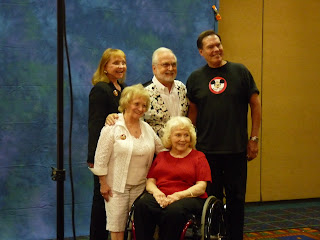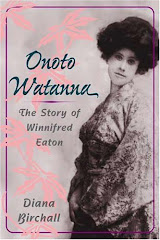Laying flowers on the grave of Dame Christabel Pankhurst
I confess, the flowers were...borrowed
I've been writing a novel about the Suffragettes, and in the past year have become passionately involved with them - particularly the Pankhursts. How interesting they are! I was lucky enough to get an almost unobtainable tape of the brilliant BBC series Shoulder to Shoulder (1975), with Sian Phillips as Mrs. Pankhurst, and Patricia Quinn and Angela Down as Christabel and Sylvia. Filmed about the same time as I, Claudius, it has never been made available in any format, and I only saw this exceptionally fine television drama as a grainy old bootleg tape made by a crew member. Even so, it was stunning. It's possible to hear a bit of the stirring Suffragette anthem, "March of the Women" (by Dame Ethel Smyth and Cicely Hamilton) and see a scene from Shoulder to Shoulder, here:
So a clean tape must exist somewhere, and we can only hope it will be re-released some day. It's too good to be so lost and forgotten.
How these women fought, what courage they had! Mrs. Pankhurst, ladylike and charismatic, using her refinement as a weapon; the beautiful powerful Christabel; the gentle dissident Sylvia.
Annie Kenney and Christabel
Fascinated as I have been with English Suffragism, it never occurred to me that one of these women would or could have ended up in Santa Monica (though my own life should have taught me that Santa Monica can happen to anyone). The Pankhursts were a Manchester family, and Christabel was born in 1880, the daughter of Emmeline Pankhurst and lawyer Richard Marsden Pankhurst. She was named Christabel after the poem by Coleridge:
'T is a month before the month of May,
And the Spring comes slowly up this way.The lovely lady, Christabel,
Whom her father loves so well,
What makes her in the wood so late,
A furlong from the castle gate?
She had dreams all yesternight
Of her own betrothed knight;
And she in the midnight wood will pray
For the weal of her lover that's far away.
Not very appropriate for Christabel, really, except for the line about her father.
Christabel
After Richard's death, Emmeline and her daughters founded the Women's Social and Political Union (WSPU), in 1903. Christabel studied law and was awarded her LL.B. with first-class honors in 1906, but as a woman, could not be admitted to the bar or practice. The Pankhursts took their activist campaigning to London, and led many protests, such as the massive gathering of nearly half a million women in Hyde Park in 1908. The Pankhursts, like other Suffragettes, all spent time in jail; Christabel was the first to be arrested. An extremely charismatic leader (the press dubbed her Queen Christabel), she favored concentrating recruitment efforts on women of the upper classes, as they could be more influential, while Sylvia wanted to work for the poor working women in the East End. This led to a schism in the organization as well as in the family, and as the Suffragettes' actions became more militant, Christabel left for France and directed WSPU activities from there.
Christabel as a graduate lawyer
After the war, women in England finally gained the vote in 1918, and Christabel was an early woman candidate for election to Parliament but lost by a slim margin. The Parkhursts then went separate ways; Sylvia, who was a Socialist, bore an illegitimate son and moved to Ethiopia, while Christabel became an Adventist, member of a movement that believed in the Second Coming and the approaching end of the world. She wrote books with titles like The Lord Cometh!, and lectured widely. The death of her mother in 1928 was a great grief, but she recovered, adopted a daughter, and in 1936 was made a Dame Commander of the British Empire. In 1940 she moved to Santa Monica, where her daughter was living, and a biographer writes that she was seen as "a strange combination of former suffragist revolutionary, evangelical Christian and almost stereotypically proper 'English lady' who always was in demand as a lecturer."
An elderly widow who was murdered by a serial killer left a comfortable income to Christabel in her will. But Christabel's own death was mysterious: she had never been ill in her life, but in 1958, her housekeeper found her dead, sitting in a chair, with nothing to show how she had died.
So that's how she came to be buried in Woodlawn Cemetery on 14th Street in Santa Monica. This is a place I've driven by countless times, seeing a stretch of grass and graves out of the corner of my eye, but never investigating. Until now. Paul and I drove in to look for Christabel, but found it quite an interesting historical adventure.
Woodlawn Cemetery
The pavilion devoted to the Brotherly Protective Order of Elks. Statues of elk dance around the periphery. Only in California!
Woodlawn Cemetery is old - it's been there since soon after Santa Monica was settled, in the 1880s (folks, this is ancient in California terms!). And having been built in a time when there was actually space out here, it's sprawling, 26 acres with 60,000 graves, many of them of minor movie stars or local historical figures like Abbot Kinney, who founded the delightfully louche city of Venice, California. Here are some interior scenes:
Paul at the "Library of Living Memories"
A very old cemetery map
A very modern "Find a Grave" system
A former library colleague of Paul's was transferred to the cemetery (not a euphemism for his demise; he just has acquired an enviable permanent job), and he and the other very kind young staff members sent us on our way to find Christabel, outfitted with maps. It actually wasn't easy, and took some, er, digging...
Paul searching...
She's under the tree
Found her!
It was a lovely sight to see
The lady Christabel, when she
Was praying at the old oak tree.
I don't think it's an oak tree she's under, though; looks more like a eucalyptus.
First bonus question: Could Jane Austen have read "Christabel"? Possible, it was published in 1816, though written much earlier, and she died in 1817. But although it's considered an early inspiration for vampire stories, it wouldn't have affected Austen's satire of the Gothic in Northanger Abbey.
Second bonus question: Should Paul rename his cat Catullus, and call her Christabel? She's much more of a Christabel than a Catullus.
Catullus or Christabel?
Third bonus question: Should we adopt a fourth cat? I have my eye on a little tortoiseshell that looks like the younger sister of ours. I would call her Quatre...
Next post: Another Suffragette, and a necklace...
Next post: Another Suffragette, and a necklace...







































































